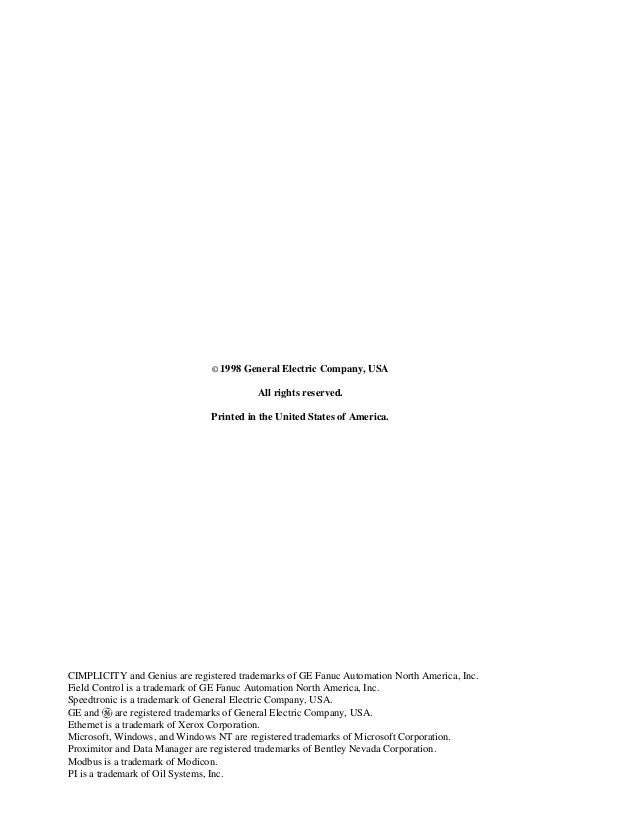Ge Speedtronic Mark Vi Manual
Fig.-16-2-Engineer-testing-a-Speedtronic%E2%84%A2-Mark-IV-panel-with-TMR-System-on-right.jpg' alt='Speedtronics Motors' title='Speedtronics Motors' />General electric mark vi manual explore ge mark vi manual 1 uosm see note 6. Introduction to SPEEDTRONIC Mark VIGeneral overview of the control system. The Unit Control Panel UCP The Speedtronic Mark VI controlling system can be found here Connected to all the instrumentations with field cabling Controlling the field instruments based on its internal software, the signals received from the field sensors and the operator commands. The Operator Interface HMI Connected to the Mark VI in the UCP Industrial PC running Windows operating system The internal software of the Mark VIcan be modified from the HMI The operator can monitor the most important field processes on the HMI The operator can give commands to the Mark VI through the HMI e. The Unit Control Panel UCPMark VI can be in two different configurations Triple Modular Redundant TMR Employs three identical control processors lt R, lt S and lt T and each performs identical operations for redundancy. Speedtronics Gearbox' title='Speedtronics Gearbox' />Very stable and reliable. Simplex Similar like TMR, but employs only a single control processor lt R, without redundancy Heavy duty gas turbines TMR or Simplex Mark VI configuration, turbine maximum shaft speed up to around 5. RPM Aeroderivative gas turbines Simplex Mark VI configuration, turbine maximum shaft speed up to 1. RPM or more. The UCP and the HMIFour main sections ACPAux. Control Panel TCPTurbines Control Panel HIOS High Input Output Signal LIOS Low Input Output SignalThe UCP Section. LMS-60HZ.jpg' alt='Speedtronic Drive To Workshop' title='Speedtronic Drive To Workshop' />Introduction The Mark VIe control system is a flexible platform used in multiple applications. It features highspeed, networked inputoutput IO for simplex, dual. Ge Speedtronic Mark Vi Manual' title='Ge Speedtronic Mark Vi Manual' /> The UCP ACP section. The UCP ACP section. TCPHIOSLIOS The Mark VI controller. UCP additional elements Pushbuttons, lamps on the external door Terminal boards for field signal connections Barriers for protection or signal conversion. UCP door pushbuttons and lamps. UCP terminal boards. UCP barriers. Panel documentation. The Control system schematic. Ericsson Mini Link Craft Software. Describes the interconnection between the standalone devices Unit Control Panel Operator Interface HMI DCS Fire Gas controller Vibration monitor. The Instrument List. Lists all the input and output signals of the UCP including Signal name Customer tag Signal description Transmitter type Calibration range Analog setpoints. Piping and Instrument Diagram P ID Displays all the intruments and sensors present on the field and the connection between them and the Mark VIcontrol system One page of the P ID describes one coherent part of the instrumentation e. Lube oil system Usually each P ID page have a graphic page ordered to it in the HMI This allows the operator to understand and monitorcontrol all the instrumentation. The Functional description. Describes the Mark VIinternal software explaining each procedure of the control processes, for example Startup process Shutdown process Different motors, fans, heaters sequencesauxiliary sequencesSignal identification All a panel documentations are using standard naming for the signals. For example we can find a device name 8. HQ According the standard naming, the number in the signal name shows the device type 8. Fire and gas trasmitter 9. LVDT 4. 9 overload 2. According the standard naming, the letters in the signal name shows the signal type E emergency R ratchet Q oil H hydraulic A auxiliary F fuel G gas. Mark VI software tagname prefixes L Logic digital signal 0 1 A Analog signal. Examples L5. 2QA lube oil auxiliary pump running A6. HQ hydraulic oil pressure L3. HR hydraulic ratchet limit switch. Proceed to SPEEDTRONIC Mark VI Hardware Description. Go back to the previous page.
The UCP ACP section. The UCP ACP section. TCPHIOSLIOS The Mark VI controller. UCP additional elements Pushbuttons, lamps on the external door Terminal boards for field signal connections Barriers for protection or signal conversion. UCP door pushbuttons and lamps. UCP terminal boards. UCP barriers. Panel documentation. The Control system schematic. Ericsson Mini Link Craft Software. Describes the interconnection between the standalone devices Unit Control Panel Operator Interface HMI DCS Fire Gas controller Vibration monitor. The Instrument List. Lists all the input and output signals of the UCP including Signal name Customer tag Signal description Transmitter type Calibration range Analog setpoints. Piping and Instrument Diagram P ID Displays all the intruments and sensors present on the field and the connection between them and the Mark VIcontrol system One page of the P ID describes one coherent part of the instrumentation e. Lube oil system Usually each P ID page have a graphic page ordered to it in the HMI This allows the operator to understand and monitorcontrol all the instrumentation. The Functional description. Describes the Mark VIinternal software explaining each procedure of the control processes, for example Startup process Shutdown process Different motors, fans, heaters sequencesauxiliary sequencesSignal identification All a panel documentations are using standard naming for the signals. For example we can find a device name 8. HQ According the standard naming, the number in the signal name shows the device type 8. Fire and gas trasmitter 9. LVDT 4. 9 overload 2. According the standard naming, the letters in the signal name shows the signal type E emergency R ratchet Q oil H hydraulic A auxiliary F fuel G gas. Mark VI software tagname prefixes L Logic digital signal 0 1 A Analog signal. Examples L5. 2QA lube oil auxiliary pump running A6. HQ hydraulic oil pressure L3. HR hydraulic ratchet limit switch. Proceed to SPEEDTRONIC Mark VI Hardware Description. Go back to the previous page.